Discover Florida Nature
It's time to explore the natural Florida


|
|
|
|
|
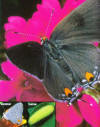 Gray
Hairstreak- Widespread and abundant, the Gray Hairstreak is
one of the most common hairstreak butterflies in Florida. This butterfly
is extremely fond of flowers and a frequent garden visitor. A smaller
butterfly with a wingspan of only 1.0- 1.5 inches, the Gray Hairstreak
has small hair like tails on its hind wing which resemble antennae and
help deflect the attack of would be predators. This charade is enhanced
by the bright orange eyespots and converging lines on the wings below
that draw attention to the unique feature. Gray
Hairstreak- Widespread and abundant, the Gray Hairstreak is
one of the most common hairstreak butterflies in Florida. This butterfly
is extremely fond of flowers and a frequent garden visitor. A smaller
butterfly with a wingspan of only 1.0- 1.5 inches, the Gray Hairstreak
has small hair like tails on its hind wing which resemble antennae and
help deflect the attack of would be predators. This charade is enhanced
by the bright orange eyespots and converging lines on the wings below
that draw attention to the unique feature. Hackberry
Butterfly - The Hackberry Butterfly has a strong, rapid flight
and rarely ventures out into open areas. With a wingspan of 2.0-2.6
inches, this butterfly perches on sunlit leaves, overhanging branches or
tree trunks along forest trails and woodland edges. Males readily
establish territories and dart out to engage passing objects or make
exploratory flights. Adult Hackberry butterflies are drawn to sap flows
or rotting fruit. Although often spotty in distribution, these
butterflies can be relatively abundant when encountered. Hackberry
Butterfly - The Hackberry Butterfly has a strong, rapid flight
and rarely ventures out into open areas. With a wingspan of 2.0-2.6
inches, this butterfly perches on sunlit leaves, overhanging branches or
tree trunks along forest trails and woodland edges. Males readily
establish territories and dart out to engage passing objects or make
exploratory flights. Adult Hackberry butterflies are drawn to sap flows
or rotting fruit. Although often spotty in distribution, these
butterflies can be relatively abundant when encountered. 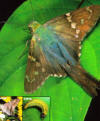 Long-tailed
Skipper
- The Long Tailed Skipper is one of the most common and distinctive
Skippers in Florida and, with a wingspan of 1.5 - 2.0 inches, it
resembles a small swallowtail. Adults have a quick, low flight. These
butterflies are fond of flowers and are often abundant in home gardens.
The larvae construct individual shelters on the host by folding over
small sections of a leaf with silk. Older larvae may use the entire leaf
or connect several leaves together. The Long Tailed Skipper is a
migratory butterfly and moves southward each fall to overwinter in
warmer portions of Southern Florida. Long-tailed
Skipper
- The Long Tailed Skipper is one of the most common and distinctive
Skippers in Florida and, with a wingspan of 1.5 - 2.0 inches, it
resembles a small swallowtail. Adults have a quick, low flight. These
butterflies are fond of flowers and are often abundant in home gardens.
The larvae construct individual shelters on the host by folding over
small sections of a leaf with silk. Older larvae may use the entire leaf
or connect several leaves together. The Long Tailed Skipper is a
migratory butterfly and moves southward each fall to overwinter in
warmer portions of Southern Florida.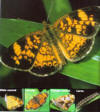 Pearl
Crescent- The lovely tawny-orange Pearl Crescent is Florida's
most widespread and abundant crescent butterfly. It is seasonally
variable, and spring and fall butterflies are darker and more heavily
patterned on the ventral hindwings. The Pearl Crescent is an
opportunistic breeder, continually producing new generations as long as
favorable conditions allow. The Pearl crescent has a rapid, erratic
flight and its wingspan is .9 - 1.2 inches. Males perch on low
vegetation with wings outstretched and frequently patrol for females.
Freshly emerged males often gather at moist ground. Pearl
Crescent- The lovely tawny-orange Pearl Crescent is Florida's
most widespread and abundant crescent butterfly. It is seasonally
variable, and spring and fall butterflies are darker and more heavily
patterned on the ventral hindwings. The Pearl Crescent is an
opportunistic breeder, continually producing new generations as long as
favorable conditions allow. The Pearl crescent has a rapid, erratic
flight and its wingspan is .9 - 1.2 inches. Males perch on low
vegetation with wings outstretched and frequently patrol for females.
Freshly emerged males often gather at moist ground. Monarch
-The monarch butterfly is undoubtedly, the most familiar and widely
recognized butterfly in North America. Monarch butterflies annual fall
mass migration is one of the greatest natural events undertaken by any
organism on Earth. Adults have a strong, soaring flight and it is an
abundant garden visitor. With a wingspan of 3.5-4.0 inches this
beautiful orange and black butterfly clearly advertises its unpleasant
taste. The striped larvae feed on plants in the Milkweed family from
which they sequester toxic chemicals that make them make them highly
distasteful to certain predators. Monarch
-The monarch butterfly is undoubtedly, the most familiar and widely
recognized butterfly in North America. Monarch butterflies annual fall
mass migration is one of the greatest natural events undertaken by any
organism on Earth. Adults have a strong, soaring flight and it is an
abundant garden visitor. With a wingspan of 3.5-4.0 inches this
beautiful orange and black butterfly clearly advertises its unpleasant
taste. The striped larvae feed on plants in the Milkweed family from
which they sequester toxic chemicals that make them make them highly
distasteful to certain predators.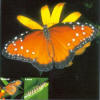 Queen
- The Queen, while superficially similar in appearance to the closely
related Monarch, does not undertake massive annual migrations. Adult
Queens, with an average wingspan of 3.0- 3.5 inches, have a slow soaring
flight and are fond of flowers. The Queen Butterfly is a frequent garden
visitor and typically rests and feeds with its wings closed. The larvae
feed on plants in the Milkweed family and sequester various chemicals
that render the butterfly highly distasteful to certain predators. Queen
- The Queen, while superficially similar in appearance to the closely
related Monarch, does not undertake massive annual migrations. Adult
Queens, with an average wingspan of 3.0- 3.5 inches, have a slow soaring
flight and are fond of flowers. The Queen Butterfly is a frequent garden
visitor and typically rests and feeds with its wings closed. The larvae
feed on plants in the Milkweed family and sequester various chemicals
that render the butterfly highly distasteful to certain predators.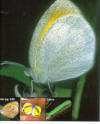 Barred Barred 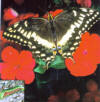 Palamedes
Swallowtail
- The Palamedes is Florida's most commonly encountered swallowtail.
Adults have a wingspan of 3.5 - 5.5 inches, and have a strong directed
flight. These butterflies avidly nectar at available blooms. Male
Palamedes often congregate at moist ground to imbibe diluted minerals
and salts. The larvae have an enlarged thorax with a prominent pair of
false eyespots that resemble the head of a small lizard or snake. Palamedes
Swallowtail
- The Palamedes is Florida's most commonly encountered swallowtail.
Adults have a wingspan of 3.5 - 5.5 inches, and have a strong directed
flight. These butterflies avidly nectar at available blooms. Male
Palamedes often congregate at moist ground to imbibe diluted minerals
and salts. The larvae have an enlarged thorax with a prominent pair of
false eyespots that resemble the head of a small lizard or snake.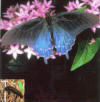 Pipevine
Swallowtail - A relatively small member of the family, with a
wingspan of 2.75 - 4.00 inches, the Pipevine Swallowtail nevertheless
has a strong rapid flight. Adults frequently visit flowers but rarely
linger at any one blossom for long. Pipevine Swallowtails continuously
flutters their wings while feeding. The velvety black larvae sequester
various toxins from their host. These chemicals render the larvae and
adults highly distasteful to many predators. As a result, several other
butterfly species mimic the color pattern of the Pipevine Swallowtail in
order to gain protection. Pipevine
Swallowtail - A relatively small member of the family, with a
wingspan of 2.75 - 4.00 inches, the Pipevine Swallowtail nevertheless
has a strong rapid flight. Adults frequently visit flowers but rarely
linger at any one blossom for long. Pipevine Swallowtails continuously
flutters their wings while feeding. The velvety black larvae sequester
various toxins from their host. These chemicals render the larvae and
adults highly distasteful to many predators. As a result, several other
butterfly species mimic the color pattern of the Pipevine Swallowtail in
order to gain protection.
|
|
|
Advertise | Privacy Statement | Contact | Alaska Nature | Michael Arnold Art| Dog Encyclopedia | Dog Encyclopedia| |
|